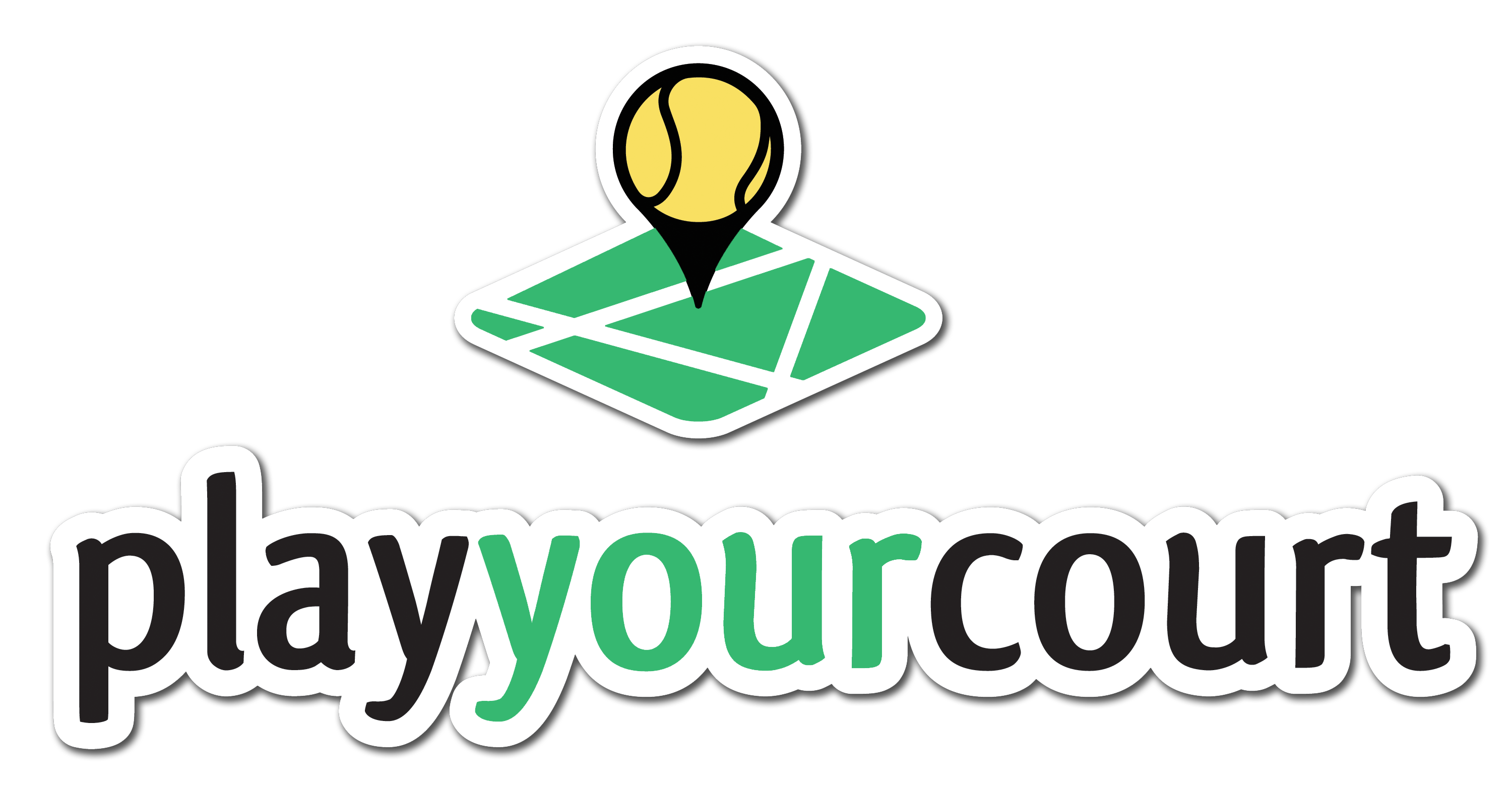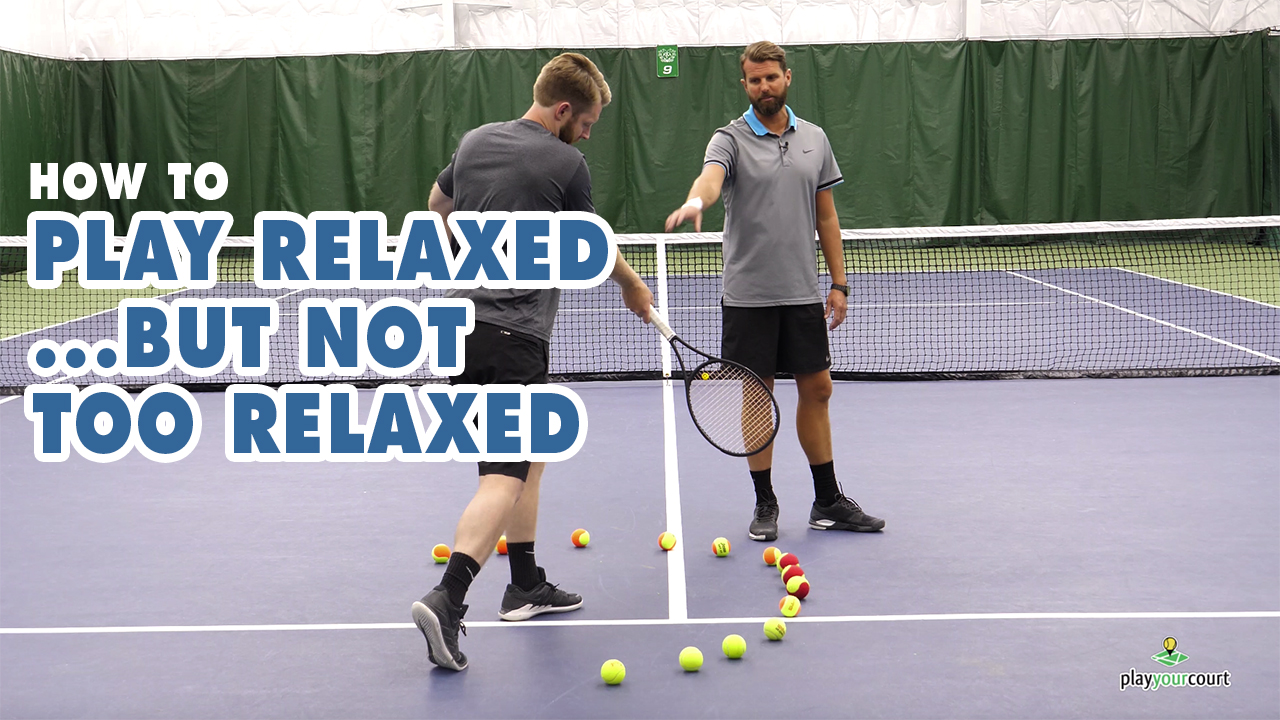Today we show you how to play relaxed, but not too relaxed for optimal tennis. This video is for tennis players with a PlayYourCourt rating of 79 and below.
Click here to get your custom video coaching: http://bit.ly/315Rsvf
How to Play Tennis Relaxed and Loose
Hey guys, Nate and Scott here with playyourcourt.com. Today we’re talking about how to play relaxed.
But not too relaxed.
How to be loose but not too loose. Don’t worry, I’ll explain in a second. This video is for players with a player court rating of 79 and below. If you’re not in our community, or familiar with our rating system, definitely click the button to the link and check us out. But a player court 79 is the equivalent of around a U-S-T-A four point five. All right so Nate, I see so many coaches telling their players, “just relax your hand, you’ll hit a better forehand” or “just relax your hand, you’ll hit a better serve.” And what I see when I walk around a lot of rec courts is a bunch of Gumby looking characters like the little floppy doll outside of a used car sales lot. And it’s just like that’s not what we mean, there’s more to it here than just, relaxing and turning into Gumby, there are certainly times you still have to apply pressure here, right?
Yeah I think sometimes it’s just a little bit too vague in the description of what we’re being coached, right? Like, do we want to be loose? Absolutely. But fluidity is really taking place and staying loose is taking place on the take back of the racket, and really allowing the racket to drop. And reaching into the lag and getting through the slot. But we can’t necessarily make contact with this entirely loose hand. Like, I think the reason we hear it so much in coaching
I think the reason we hear it so much in coaching is that there are so many death grips, right? And that is a problem, but we do need to address that when tension is applied. So as I take the racket back, and it’s really loose and it’s coming through I do need some tension at contact. All right? I’ve got to squeeze the racket just a little bit to make sure I’m not losing the integrity of the racket, the frame, through contact of the ball. And then from there it re-enters ya know, being loose through that follow through. But we’ve got to demonstration today that we’re going to show you that I think does a really good job at illustrating this. All right, we got to get away from these ya know, snapping the wrist and a lot that’s just non-sense. Yeah So
Illustrating the Swing Path
Okay guys, so as you can see we’ve got tennis balls surrounding Scott and this is actually going to illustrate the swing path that he’s going to use on the take back. All right, so this yellow ball should represent very little tension. All right, then the important thing to note here is Scott using his left hand to take the racket back. So Scott if you’ll go ahead and run through that unit turn. And this is really, this take back here, is where there’s just very little tension. If at any.
Very relaxed, you could knock the racket out of my hand right now.
The left hand is, when you say like, the left hand is doin the majority of the work getting the racket back.
All right, and so with the hand being really really loose here it allows the racket to build momentum and build leverage as it moves towards the ball. All right so run through that one more time. All right and you can see here because his hand is loose as he starts to turn the hip, the racket will fall into the lag, which will enter the slot. Al right, fire the hips for me, let it go. All right and it’s not until really, we get it to contact that we’re going to start seeing this tension. So we’re going to kind of illustrate this in another way so you can really see.
But the first part of this is the take back, is where you have very, very little tension. All right, like Scott said, enough to take the racket out of your hand, right? All right so let’s show you the second illustration now. All right guys so this time we’re back with the illustration of Scott’s swing path forward, just a moment ago we talked about the racket take back, entering the lag, the slot. The racket acceleration all having very, very little tension, okay?
The tension grip
Now we’re going to talk about where the racket, where the hand actually imparts tension to the grip. So Scott, if you’ll go ahead and work through this linear strike, you’ll see his racket through here stays very, very loose. Okay? And you can tell like he’s breathing here. Like the automated response of breathing because that is how he knows to keep things loose. The orange ball is representing a little bit more tension, and then as he enters through the red ball, that’s contact, right? So like the racket comes through contact, still an increase in pressure, right? Because otherwise what would happen if it was loose just like it was on the back swing, you would have the racket giving way to the ball.
Yeah. 100% right, so he’s got to have some, some grip strength here. Now if you slowed this down contacting the ball the racket does do this, okay? But that’s entirely different from making contact, and then giving way and the ball taking leverage over the racket. So through here, through contact red, red, red, and then you can see that the grip then startens to lighten up.
Relaxation time
Yeah a little bit of relaxation as it gets through, but there is going to be some firmness, all right? This is important, notice we didn’t go all the way back to the yellow ball on this illustration. The reason being is that, you’re running out of room and the body knows to start braking. All right, because you’re not doin this where it’s just slapping around. Your body’s controlling the swing, even though the arm is loose. All right, but we still need a little bit of firmness to get it through that follow-through so we’re not over rotating, okay? So really focusing on the firmness at contact. All right so let’s dispel a myth while we’re discussing this.
All right, I hear a lot of people out there talking about pronating with the wrist. And this kind of ridiculous wrist snap thing that I’m seeing people trying to teach, demonstrate. It’s bad news guys. A really easy way to get hurt. All right, so what we’re going to show is Scott if you’ll go through that swing path again, what we want to talk about here is how Scott’s actually pronating with the forearm. Yes, the wrist pronates but it only pronates because it has to go where the forearm goes. So start turnin over through your pronation, so you’ll see, and turn it over, turn it over and you’re free, and you’ll see freeze. All right, so that there right, the forearm. Those muscles are activated because he has pronated, he’s turning it over, and the wrist is a by-product of that. Which, yes do you need to have your wrist loose? 100% all right? But we pronate with the forearm and the wrist follows.
All right guys so in quick summary here, you’re not always going to focus on completely relaxing your hand. Yes, we want a relaxed take back, we need a little bit of pressure at contact followed with a relaxed follow-through and then a little bit of tension again on the follow-through to make sure we’re not just uncontrollably swingin our arms around. So hopefully this helps, this is the one thing that really, I think, even at all skill levels can be applied. Not all of our instruction is like that, unfortunately a lot of instruction, particularly for division one college tennis players verse a beginner changes quite a bit based on your skill level. So do us a favor, click the button or the link below, answer a couple questions for Nate and I about your specific skill level. Jump into the play your court community 5 bucks a month. We send you custom video coaching every single week based on the things you’ve got going on, and your specific game. And we also help you connect with some local players at your skill level so you can practice and play some matches. And give this stuff a try on court. Click the button or link below, jump inside the tennis community and we’ll see you soon.

